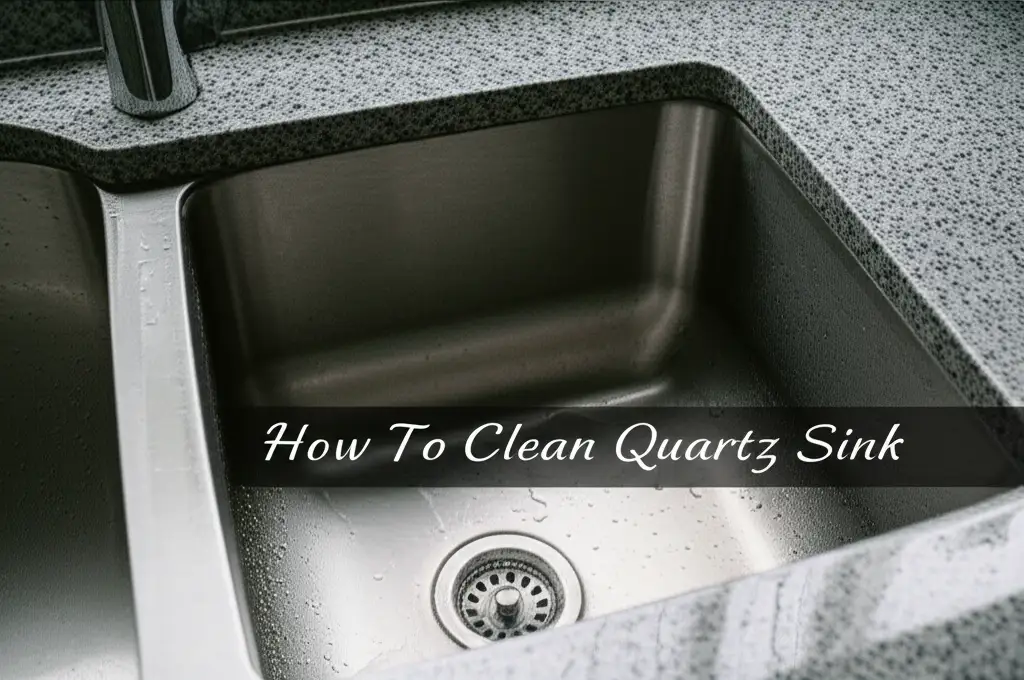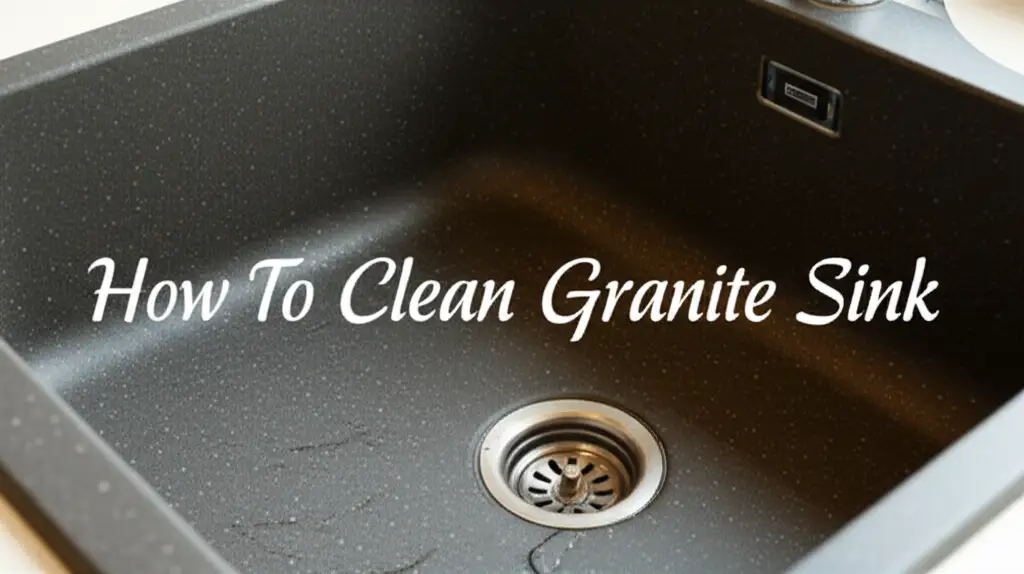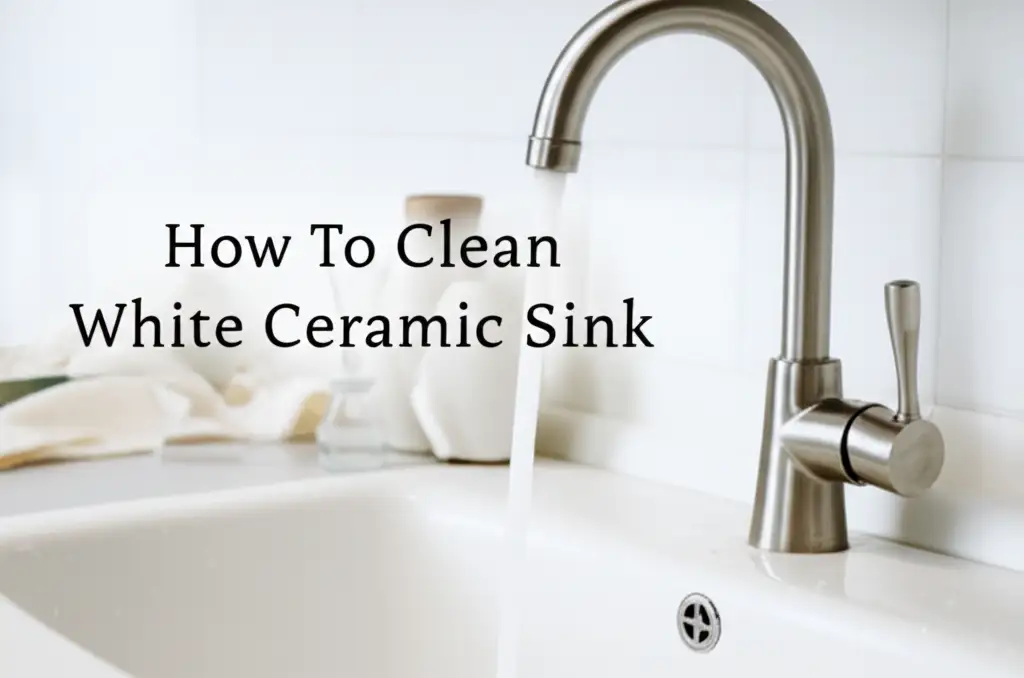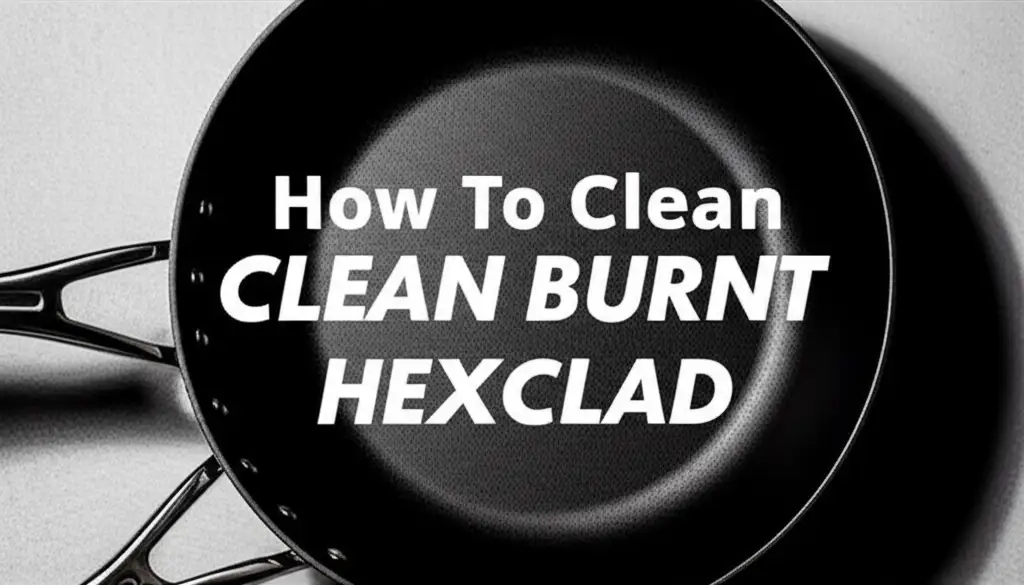· Kitchen Cleaning · 14 min read
How To Clean Quartz Sink

Unlock the Shine: How to Clean Your Quartz Sink
My kitchen sink sees a lot of action daily. If you have a quartz sink, you know its beauty and durability are outstanding. However, even the toughest materials need proper care. Learning how to clean quartz sink surfaces correctly keeps them looking new. This guide helps you maintain its pristine condition. We will explore daily cleaning, deep stain removal, and important maintenance tips. You can keep your quartz sink beautiful for years with the right approach.
Takeaway:
- Clean your quartz sink daily with mild soap and water.
- Address tough stains like food, grease, or hard water using specific methods.
- Avoid abrasive cleaners and harsh chemicals to protect the sink’s surface.
- Perform routine maintenance to prevent buildup and maintain shine.
- Protect your quartz sink from extreme heat and heavy impacts.
Cleaning your quartz sink requires mild solutions and soft tools. Use dish soap and warm water for daily cleaning. For stubborn stains, a mixture of vinegar and water or a specialized quartz cleaner works well. Rinse thoroughly and dry the sink after each cleaning to prevent water spots.
Understanding Quartz Sinks: What Makes Them Special?
Quartz sinks are popular choices for modern kitchens. They offer a blend of beauty, strength, and low maintenance. Quartz sinks are not solid quartz. They consist of about 70-80% quartz stone particles. Resins bind these particles together. This composite material makes the sink highly durable. It resists scratches, chips, and heat better than many other sink materials.
I chose a quartz sink for its unique look and promised longevity. The non-porous surface of quartz is a major benefit. This means liquids and stains do not easily penetrate the material. This feature makes quartz sinks hygienic and easy to clean. It also prevents the growth of mold and mildew. Many homeowners value this benefit. If you have quartz countertops, you know this material is robust. Learn more about how to clean quartz countertop for comprehensive care.
Different manufacturers create quartz sinks. Each brand uses specific resin blends. This can affect the sink’s exact properties and recommended care. For example, some quartz materials, like Cambria, have specific cleaning needs. You can learn more about how to clean Cambria quartz if you have these countertops. Understanding your specific quartz sink helps you choose the best cleaning method. The composite nature of quartz sinks makes them highly resistant to common kitchen issues.
Everyday Cleaning for Quartz Sinks: Keeping it Pristine
Regular cleaning prevents dirt buildup and maintains your sink’s appearance. Daily care is simple and quick. I clean my quartz sink after each use, especially after preparing food. This simple habit keeps stains from setting in. It makes deep cleaning less frequent.
Start with warm water and a small amount of mild dish soap. I prefer a gentle, pH-neutral soap. Apply the soapy water to the sink’s surface. Use a soft cloth or a non-abrasive sponge. Gently wipe down all areas of the sink. Pay attention to corners and edges where debris might collect. Rinse the sink thoroughly with clean water. Make sure no soap residue remains. Soap residue can dull the finish over time.
Finally, dry the sink with a clean, soft towel. This step is important to prevent water spots. Water spots are common, especially in areas with hard water. Drying keeps your quartz sink sparkling. This routine also helps maintain the sink faucet. A clean sink looks better with a sparkling faucet. You can find tips for cleaning your how to clean sink faucet to complete the look.
For light scuffs, a melamine foam eraser, often called a magic eraser, works well. Dampen the eraser slightly. Gently rub the scuff marks. Always test this method in an inconspicuous area first. This daily routine helps protect the beautiful surface of your quartz sink. It ensures your sink stays a highlight of your kitchen.
Tackling Tough Stains: Deep Cleaning Your Quartz Sink
Even with regular cleaning, tough stains can appear. Food, grease, and mineral deposits challenge any sink. Knowing how to remove these stubborn marks helps maintain your quartz sink’s beauty. Different stains require specific approaches. I have faced many types of stains in my own sink.
Food Stains and Grease
Food stains, like coffee, tea, or wine, can leave marks. Grease from cooking is also a common problem. For these stains, a paste of baking soda and water works wonders. Mix a few tablespoons of baking soda with enough water to form a thick paste. Apply this paste directly to the stained area. Let it sit for about 15-20 minutes. The baking soda gently lifts the stain. After waiting, scrub the area with a soft brush or sponge. Rinse thoroughly with warm water. Dry the sink completely. This method is safe for your quartz sink.
For heavier grease buildup, a degreaser formulated for kitchen use is effective. Choose a non-abrasive cleaner. Spray it on the greasy areas. Let it sit for the recommended time on the product label. Then, wipe away with a soft cloth. Always rinse well to remove all cleaner residue. You can also explore methods for how to clean composite sink materials, as many quartz sinks share similar cleaning needs with composites.
Mineral Deposits and Hard Water Stains
Hard water leaves mineral deposits and unsightly white spots. These are often tough to remove with just soap and water. Vinegar is an excellent natural solution for mineral buildup. Mix equal parts white vinegar and water in a spray bottle. Spray the solution generously over the affected areas. Let it sit for 10-15 minutes. The acidity of the vinegar dissolves the minerals.
For very stubborn deposits, you can increase the vinegar concentration. You can even use undiluted vinegar for short periods. After the vinegar sits, scrub the area with a non-scratch pad or soft brush. Rinse thoroughly with water. Dry the sink immediately to prevent new spots. Using vinegar is a safe and effective way to clean many parts of your sink, including the drain. Find more tips on how to clean sink drain with vinegar.
Restoring Shine: Dealing with Discoloration and Scratches
Over time, your quartz sink might lose some of its original luster. Discoloration can occur from various factors. While quartz is scratch-resistant, it is not scratch-proof. Understanding how to restore its shine and minimize the look of scratches is important for long-term care. I always aim to keep my sink looking as good as new.
Discoloration often comes from hard water buildup or residues from certain foods. For general dullness, a deeper clean can help. After cleaning with baking soda or vinegar, consider a specialized quartz cleaner. These cleaners are designed to restore the material’s original shine. Always follow the product’s instructions carefully. Apply with a soft cloth. Buff gently to bring back the luster. Many of these products also leave a protective layer.
While quartz is durable, heavy impacts or sharp objects can leave minor scratches. True scratches cannot be buffed out like on some other materials. However, often what looks like a scratch is residue from metal pans or utensils. Metal marks appear as dark lines on the quartz surface. These are not true scratches on the quartz itself.
To remove metal marks, try a non-abrasive cream cleanser. Apply a small amount to a soft cloth. Rub the mark gently until it disappears. Rinse the area thoroughly with water. Dry the sink completely. Prevention is key. Avoid dragging heavy or sharp objects across the sink surface. Always use cutting boards. These small habits protect your sink from superficial damage and maintain its appearance. Keeping darker sinks clean sometimes presents unique challenges, so check out tips for how to clean black kitchen sink for more ideas.
Preventative Care: Protecting Your Quartz Sink’s Luster
The best cleaning strategy involves proactive steps. Preventing problems saves time and effort later. Proper preventative care keeps your quartz sink beautiful for years. I follow several simple rules to protect my sink. These rules help maintain its original shine and integrity.
Firstly, always rinse your sink after use. Food particles, coffee, or wine can leave stains if left to dry. A quick rinse with water prevents most immediate issues. Use a mild dish soap solution for daily wiping. This simple act prevents buildup. Drying the sink after each use is also vital. This stops hard water spots from forming. Hard water spots are difficult to remove once they calcify.
Secondly, avoid harsh chemicals. Quartz sinks are tough, but certain cleaners harm the resin binders. Products containing bleach, ammonia, or abrasive particles can dull the finish or damage the surface. Always check the labels of cleaning products. Stick to cleaners specifically marked as safe for quartz or stone surfaces. Using mild soap and water is almost always the safest option. This care is similar to what you might use for other composite materials. For example, methods for how to clean Silgranit sink also emphasize gentle cleaners.
Thirdly, protect your sink from extreme heat and heavy impacts. Although quartz is heat-resistant, sudden temperature changes can cause thermal shock. Always use a trivet or hot pad under hot pots and pans. Never place them directly into your quartz sink. Dropping heavy objects can chip or crack the sink. Be careful when handling cast iron pots or heavy cookware around the sink. These protective measures keep your quartz sink looking pristine.
Common Mistakes to Avoid When Cleaning Quartz Sinks
Cleaning a quartz sink is straightforward, but certain practices can cause damage. Avoiding common mistakes helps prolong the life and beauty of your sink. I learned some of these lessons the hard way. Knowing what not to do is as important as knowing what to do.
First, do not use abrasive cleaners or scouring pads. Steel wool, gritty powders, or rough sponges can scratch the quartz surface. Even though quartz is scratch-resistant, repeated abrasive action will dull its finish. Always use soft cloths, sponges, or non-scratch scrubbing pads. These tools clean effectively without damaging the surface. This is especially true for matte finishes. If you have a matte black sink, be extra careful. Learn more about how to clean matte black sink for specific advice.
Second, avoid harsh chemical cleaners. Bleach, oven cleaners, drain cleaners, and strong acids or alkalis are very harmful. These chemicals can break down the resin that binds the quartz particles. This leads to discoloration, etching, or even permanent damage. If you accidentally spill such a substance, wipe it up immediately. Rinse the area thoroughly with water. Always read product labels before using any cleaner on your sink.
Third, never let spills dry on the surface. Acidic foods like lemon juice, tomato sauce, or red wine can etch or stain the sink if left too long. Pigmented liquids like coffee or tea can also leave marks. Wipe up spills immediately. Rinse the area with water and dry it. This prevents stains from setting. It also helps prevent hard water spots. Even though quartz is non-porous, prompt cleaning is still the best practice.
Lastly, do not use metal scrapers or knives directly on the sink. These can leave metal marks. These marks embed onto the surface and are difficult to remove. Use plastic or silicone scrapers for stuck-on food. Always use a cutting board for chopping. These precautions ensure your quartz sink remains beautiful for many years.
Advanced Techniques for Stubborn Issues
Sometimes, daily cleaning and basic stain removal are not enough. Certain stubborn issues might require more targeted solutions. These advanced techniques are for specific problems like deep discoloration or adhesive residue. I keep these methods in mind for challenging situations.
Addressing Severe Discoloration
Severe discoloration can happen over time, especially in lighter colored quartz sinks. This is often due to prolonged exposure to staining agents or mineral buildup. For extensive discoloration, a gentle paste of hydrogen peroxide and baking soda can be effective. Mix equal parts to form a thick paste. Apply the paste generously over the discolored areas. Cover the paste with plastic wrap to keep it moist. Let it sit for several hours, or even overnight.
After the waiting period, remove the plastic wrap. Gently scrub the area with a soft brush or non-abrasive sponge. Rinse the sink thoroughly with warm water. Dry completely. Hydrogen peroxide helps lift deep stains. Always test this method in an inconspicuous spot first. Ensure good ventilation when using hydrogen peroxide. This method can also help revive dull areas.
Removing Adhesive or Residue
Sometimes, adhesive from labels or other sticky residues gets on the sink. Do not use sharp objects to scrape these off. This can scratch the surface. Instead, use a mild solvent. Isopropyl alcohol or mineral spirits work well for adhesive removal. Apply a small amount to a soft cloth. Gently rub the residue until it dissolves.
Once the residue is gone, clean the area with mild soap and water. Rinse thoroughly and dry the sink. Always ensure good ventilation when using solvents. Avoid prolonged contact of solvents with the quartz surface. This technique safely removes sticky substances without harming your sink.
Professional Cleaning Options
For issues you cannot resolve yourself, consider professional help. Some cleaning services specialize in quartz and stone care. They have specialized equipment and stronger, professional-grade cleaners. These experts can handle deep etching or significant damage. Professional cleaning can restore your sink’s appearance. It can also provide a protective sealant. This helps your sink resist future stains and damage. Investing in professional care ensures the longevity of your beautiful quartz sink.
FAQ Section
Q1: Can I use bleach on my quartz sink?
No, avoid using bleach on your quartz sink. Bleach contains harsh chemicals that can damage the resin binders in the quartz composite. This can lead to discoloration, dullness, or etching of the surface. Stick to mild soaps or specialized quartz cleaners for safe cleaning.
Q2: How often should I deep clean my quartz sink?
Deep clean your quartz sink as needed, usually every few weeks or once a month. Daily cleaning prevents most major buildup. If you notice tough stains or a dull appearance, it is time for a deep clean. Consistent routine care reduces the need for frequent deep cleaning.
Q3: What causes white spots on my black quartz sink?
White spots on your black quartz sink are typically caused by hard water deposits. Minerals like calcium and magnesium are left behind when water evaporates. These minerals appear as white, chalky residue. Drying your sink after each use helps prevent these spots from forming.
Q4: Can I use abrasive scrubbers on quartz sinks?
No, do not use abrasive scrubbers like steel wool or gritty scouring pads on your quartz sink. These can scratch or dull the non-porous surface. Always use soft cloths, non-abrasive sponges, or nylon brushes for cleaning. This protects the sink’s finish.
Q5: Is it safe to pour boiling water down a quartz sink?
While quartz is heat-resistant, avoid pouring large amounts of boiling water directly into the sink. Sudden temperature changes can cause thermal shock. This might lead to cracking or damage over time. Always run cold water when pouring hot liquids to help dissipate the heat.
Q6: How do I remove stubborn stains like rust from my quartz sink?
For rust stains, use a non-abrasive rust remover safe for quartz or composite sinks. Apply it according to product directions, usually for a few minutes. Then, gently scrub and rinse thoroughly. Avoid strong acidic rust removers as they can damage the sink surface.
Conclusion
Cleaning your quartz sink does not need to be a chore. With the right knowledge and tools, you can easily maintain its beautiful appearance. We have covered everything from daily simple wiping to tackling stubborn stains. We also explored how to fix discoloration and prevent future issues. Remember, gentle care is key for your quartz sink.
By following these guidelines, you protect your investment. You ensure your sink remains a stunning, functional part of your kitchen for many years. Regular attention helps prevent problems. It keeps your quartz sink sparkling day after day. You now have the full guide on how to clean quartz sink surfaces effectively. Start your routine today. Your sink will thank you for it with a lasting shine.
- quartz sink cleaning
- kitchen sink care
- stain removal




